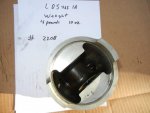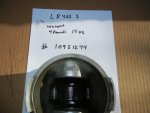Yep... and we already covered all of this.
The LDT and LDS-1 have the same turbos, blocks, cranks, rods rockers, cams, and injectors.
In rebuilt engines the pistons, pumps and timing for either can be found. There is no magic here. We already know, in great detail, what the differences are.
The prime desire is to make an LDT make LDS power by understanding the differences. So, adjust the pump to deliver LDS fuel levels into the LDT. Aside from that, get a pyro to monitor. Can you adjust timing? Of course. Is it worth it? Up to you.
Is there a different piston? Yes, to deal with the added heat with 1950s lubes. With modern fluids it is debatable as to if it is needed. The cooled LDS piston reduced temps at the top ring by 100 degrees F.
Guys, this has been beat to death.
Camshaft Fed. stock #2815 808 6978. listed as spec for everything but the LDS-2 as per TM9-2815-210-34P.
One hole vs two hole injectors could be found on either with the same fueling rate.
The power difference is the 80lb/hr the LDS is fueled at vs the 63lb/hr the LDT is fueled at. Now you can increase the fuel buy hunting down the LDS pump, or by turning up the LDT pump to match it. The LDS HH provides that higher VOLUME at a lower system pressure. (The governor assy is different to provide that fuel at different times in the RPM range) The wastegated turbo is used to allow for maximum efficiency to be reached at lower RPM levels, without overspinning at high rpm levels.
It would be better to think of the LDS as the low efficiency "towing tune" version of the engine family, with the LDT being the "fuel efficient cruiser." That's a very rough description, but for folks just getting into the system, it's a start.




